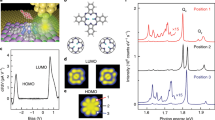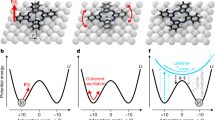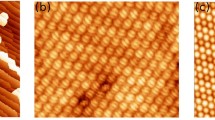Abstract
Using the tip of a scanning tunnelling microscope (STM) to mechanically manipulate individual atoms and molecules on a surface is now a well established procedure1,2. Similarly, selective vibrational excitation of adsorbed molecules with an STM tip to induce motion or dissociation has been widely demonstrated3,4. Such experiments are usually performed on weakly bound atoms that need to be stabilized by operating at cryogenic temperatures. Analogous experiments at room temperature5 are more difficult, because they require relatively strongly bound species that are not perturbed by random thermal fluctuations. But manipulation can still be achieved through electronic excitation of the atom or molecule by the electron current6,7,8,9,10,11 tunnelling between STM tip and surface at relatively high bias voltages10,11, typically 1–5 V. Here we use this approach to selectively dissociate chlorine atoms from individual oriented chlorobenzene molecules adsorbed on a Si(111)-7 × 7 surface. We map out the final destination of the chlorine daughter atoms, finding that their radial and angular distributions depend on the tunnelling current and hence excitation rate. In our system, one tunnelling electron has nominally sufficient energy to induce dissociation, yet the process requires two electrons. We explain these observations by a two-electron mechanism that couples vibrational excitation and dissociative electron attachment steps.
This is a preview of subscription content, access via your institution
Access options
Subscribe to this journal
Receive 51 print issues and online access
$199.00 per year
only $3.90 per issue
Buy this article
- Purchase on Springer Link
- Instant access to full article PDF
Prices may be subject to local taxes which are calculated during checkout




Similar content being viewed by others
References
Eigler, D. M. & Schweizer, E. K. Positioning single atoms with a scanning tunnelling microscope. Nature 344, 524–526 (1990)
Bartels, L., Meyer, G. & Rieder, K.-H. Basic steps of lateral manipulation of single atoms and diatomic clusters with a scanning tunneling microscope tip. Phys. Rev. Lett. 79, 697–700 (1997)
Komeda, T., Kim, Y., Kawai, M., Persson, B. N. J. & Ueba, H. Lateral hopping of molecules induced by excitation of internal vibration mode. Science 295, 2055–2058 (2002)
Pascual, J. I., Lorente, N., Song, Z., Conrad, H. & Rust, H.-P. Selectivity in vibrationally mediated single-molecule chemistry. Nature 423, 525–528 (2003)
Fishlock, T. W., Oral, A., Egdell, R. G. & Pethica, J. B. Manipulation of atoms across a surface at room temperature. Nature 404, 743–745 (2000)
Salam, G. P., Persson, M. & Palmer, R. E. Possibility of coherent multiple excitation in atom transfer with a scanning tunneling microscope. Phys. Rev. B 49, 10655–10662 (1994)
Stipe, B. C. et al. Single-molecule dissociation by tunneling electrons. Phys. Rev. Lett. 78, 4410–4413 (1997)
Lauhon, L. J. & Ho, W. Control and characterization of a multistep unimolecular reaction. Phys. Rev. Lett. 84, 1527–1530 (2000)
Hla, S.-W., Bartels, L., Meyer, G. & Rieder, K.-H. Inducing all steps of a chemical reaction with the scanning tunneling microscope tip: Towards single molecule engineering. Phys. Rev. Lett. 85, 2777–2780 (2000)
Lu, P. H., Polanyi, J. C. & Rogers, D. Electron-induced “localized atomic reaction” (LAR): chlorobenzene adsorbed on Si(111) 7 × 7. J. Chem. Phys. 111, 9905–9907 (1999)
Soukiassian, L., Mayne, A. J., Carbone, M. & Dujardin, G. Atomic-scale desorption of H atoms from the Si(100)-2 × 1:H surface: inelastic electron interactions. Phys. Rev. B 68, 035303 (2003)
Boland, J. J. & Villarrubia, J. S. Formation of Si(111)-(1 × 1)Cl. Phys. Rev. B 41, 9865–9870 (1990)
Nakamura, Y., Mera, Y. & Maeda, K. Diffusion of chlorine atoms on Si(111)-(7 × 7) surface enhanced by electron injection from scanning tunneling microscope tips. Surf. Sci. 487, 127–134 (2001)
Brune, H., Wintterlin, J., Behm, R. J. & Ertl, G. Surface migration of “hot” adatoms in the course of dissociative chemisorption of oxygen on Al(111). Phys. Rev. Lett. 68, 624–626 (1992)
Cao, Y., Deng, J. F. & Xu, G. Q. Stereo-selective binding of chlorobenzene on Si(111)-7 × 7. J. Chem. Phys. 112, 4759–4767 (2000)
Sloan, P. A., Hedouin, M. F. G., Palmer, R. E. & Persson, M. Mechanism of molecular manipulation with the scanning tunneling microscope at room temperature: chlorobenzene/Si(111)-(7 × 7). Phys. Rev. Lett. 91, 118301 (2003)
Li, Z.-H., Li, Y.-C., Wang, W.-N., Cao, Y. & Fan, K.-N. A density functional theory study on the adsorption of chlorobenzene on the Si(111)-7 × 7 surface. J. Phys. Chem. B 108, 14049–14055 (2004)
Jensen, J. A., Yan, C. & Kummel, A. C. Direct chemisorption site selectivity for molecular halogens on the Si(111)-(7 × 7) surface. Phys. Rev. Lett. 76, 1388–1391 (1996)
Palmer, R. E. & Rous, P. J. Resonances in electron scattering by molecules on surfaces. Rev. Mod. Phys. 64, 383–440 (1992)
Alavi, S. et al. Inducing desorption of organic molecules with a scanning tunneling microscope: theory and experiments. Phys. Rev. Lett. 85, 5372–5375 (2000)
Komeda, T., Kim, Y., Fujita, Y., Sainoo, Y. & Kawai, M. Local chemical reaction of benzene on Cu(110) via STM-induced excitation. J. Chem. Phys. 120, 5347–5352 (2004)
Jiang, G., Polanyi, J. C. & Rogers, D. Electron and photon irradiation of benzene and chlorobenzene on Si(111)7 × 7. Surf. Sci. 544, 147–161 (2003)
Martin, F. et al. DNA strand breaks induced by 0–4 eV electrons: the role of shape resonances. Phys. Rev. Lett. 93, 068101 (2004)
Dixon-Warren, St-J., Jensen, E. T. & Polanyi, J. C. Direct evidence for charge-transfer photodissociation at a metal surface: CCl4/Ag(111). Phys. Rev. Lett. 67, 2395–2398 (1991)
Palmer, R. E. Electron-molecule dynamics at surfaces. Prog. Surf. Sci. 41, 51–108 (1992)
Dressler, R., Allan, M. & Haselbach, E. Symmetry control in bond cleavage processes: dissociative electron attachment to unsaturated halocarbons. Chimia 39, 385–389 (1985)
Modelli, A. Electron attachment and intramolecular electron transfer in unsaturated chloroderivatives. Phys. Chem. Chem. Phys. 5, 2923–2930 (2003)
Skalicky, T., Chollet, C., Pasquier, N. & Allan, M. Properties of the π* and σ* states of the chlorobenzene anion determined by electron impact spectroscopy. Phys. Chem. Chem. Phys. 4, 3583–3590 (2002)
Fontanesi, C., Baraldi, P. & Marcaccio, M. On the dissociation dynamics of the benzyl chloride radical anion. An ab initio dynamic reaction coordinate analysis study. J. Mol. Struct. (Theochem) 548, 13–20 (2001)
Guyot-Sionnest, P., Dumas, P., Chabal, Y. J. & Higashi, G. S. Lifetime of an adsorbate-substrate vibration: H on Si(111). Phys. Rev. Lett. 64, 2156–2159 (1990)
Acknowledgements
We thank the EPSRC and the European Research Training Networks ‘Manipulation of individual atoms and molecules’ and AMMIST for support. P.A.S. acknowledges studentship support from the School of Physics and Astronomy and from EPSRC. We also thank J. C. Polanyi for pointing us in the direction of vibrationally activated chemical reactions.
Author information
Authors and Affiliations
Corresponding author
Ethics declarations
Competing interests
The authors declare that they have no competing financial interests.
Rights and permissions
About this article
Cite this article
Sloan, P., Palmer, R. Two-electron dissociation of single molecules by atomic manipulation at room temperature. Nature 434, 367–371 (2005). https://doi.org/10.1038/nature03385
Received:
Accepted:
Issue Date:
DOI: https://doi.org/10.1038/nature03385
This article is cited by
-
Constructing covalent organic nanoarchitectures molecule by molecule via scanning probe manipulation
Nature Chemistry (2021)
-
Combining scanning tunneling microscope (STM) imaging and local manipulation to probe the high dose oxidation structure of the Si(111)-7×7 surface
Nano Research (2020)
-
Initiating and imaging the coherent surface dynamics of charge carriers in real space
Nature Communications (2016)
-
Bond selectivity in electron-induced reaction due to directed recoil on an anisotropic substrate
Nature Communications (2016)
-
Real-space Wigner-Seitz Cells Imaging of Potassium on Graphite via Elastic Atomic Manipulation
Scientific Reports (2015)
Comments
By submitting a comment you agree to abide by our Terms and Community Guidelines. If you find something abusive or that does not comply with our terms or guidelines please flag it as inappropriate.



